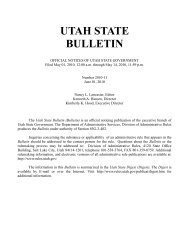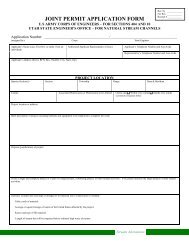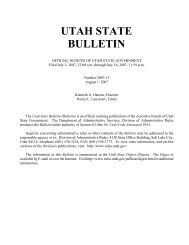Utah State Bulletin, January 15, 2012, Vol. 2012, No. 2
Utah State Bulletin, January 15, 2012, Vol. 2012, No. 2
Utah State Bulletin, January 15, 2012, Vol. 2012, No. 2
You also want an ePaper? Increase the reach of your titles
YUMPU automatically turns print PDFs into web optimized ePapers that Google loves.
DAR File <strong>No</strong>. 35578NOTICES OF PROPOSED RULEScare for more school age children as a result of this rulechange. However, because the agency has no way ofknowing if programs will increase the number of school agechildren they care for, the agency cannot anticipate what theirincreased revenue from this might be. Because the cost ofTB testing is usually born by the individual rather than thebusiness, the agency does not anticipate any cost or savingsas a result of this change.♦ SMALL BUSINESSES: Almost all child care centers aresmall businesses. These businesses may be able to care formore school age children as a result of this rule change.However, because the agency has no way of knowing ifprograms will increase the number of school age childrenthey care for, the agency cannot anticipate what theirincreased revenue from this might be. Because the cost of TBtesting is usually born by the individual rather than thebusiness, the agency does not anticipate any cost or savingsas a result of this change.♦ PERSONS OTHER THAN SMALL BUSINESSES,BUSINESSES, OR LOCAL GOVERNMENTAL ENTITIES:Businesses may be able to care for more school age childrenas a result of this rule change. However, because the agencyhas no way of knowing if programs will increase the numberof school age children they care for, the agency cannotanticipate what their increased revenue from this might be.Because the cost of TB testing is usually born by theindividual rather than the business, the agency does notanticipate any cost or savings as a result of this change.COMPLIANCE COSTS FOR AFFECTED PERSONS: TBtesting costs are born by the individual being tested.Because this rule removes the requirements for individual TBtesting, there will be some cost savings to individuals who nolonger need this test. Depending on where the test iscompleted, costs per test could range from $20 to $100. Inthose rare instances where follow-up x-rays are required,costs could range from $100 to several thousand dollars,depending on where the x-ray is done and what follow-up isrequired as a result of the x-ray.COMMENTS BY THE DEPARTMENT HEAD ON THEFISCAL IMPACT THE RULE MAY HAVE ON BUSINESSES:A careful and thorough review of child care licensing ruleswas undertaken during the last year. Health careprofessionals recommended that testing of staff fortuberculosis was not necessary. Removal of this requirementwill save business both time and money. Other changesshould also reduce regulatory burdens.THE FULL TEXT OF THIS RULE MAY BE INSPECTED,DURING REGULAR BUSINESS HOURS, AT:HEALTHFAMILY HEALTH AND PREPAREDNESS,CHILD CARE LICENSINGCANNON HEALTH BLDG288 N 1460 WSALT LAKE CITY, UT 84116-3231or at the Division of Administrative Rules.DIRECT QUESTIONS REGARDING THIS RULE TO:♦ Teresa Whiting by phone at 801-538-6320, by FAX at 801-538-6325, or by Internet E-mail at twhiting@utah.govINTERESTED PERSONS MAY PRESENT THEIR VIEWS ONTHIS RULE BY SUBMITTING WRITTEN COMMENTS NOLATER THAN AT 5:00 PM ON 02/14/<strong>2012</strong>THIS RULE MAY BECOME EFFECTIVE ON: 03/01/<strong>2012</strong>AUTHORIZED BY: David Patton, PhD, Executive DirectorR430. Health, Family Health and Preparedness, Child CareLicensing.R430-100. Child Care Centers.R430-100-2. Definitions.(1) "Accredited College" means a college accredited byan agency recognized by the United <strong>State</strong>s Department of Educationas a valid accrediting agency.(2) "ASTM" means American Society for Testing andMaterials.(3) "Body fluids" means blood, urine, feces, vomit,mucous, and saliva[, and breast milk].(4) "Caregiver" means an employee or volunteer whoprovides direct care to children.(5) "CPSC" means the Consumer Product SafetyCommission.(6) "Department" means the <strong>Utah</strong> Department of Health.(7) "Designated Play Surface" means a flat surface on apiece of stationary play equipment that a child could stand, walk,sit, or climb on, and is at least 2" by 2" in size.(8) "Direct Supervision" for infants, toddlers, andpreschoolers means the caregiver can see and hear all of thechildren in his or her assigned group, and is near enough tointervene when necessary. "Direct Supervision" for school agechildren means the caregiver must be able to hear school agechildren and must be near enough to intervene when necessary.(9) "Emotional Abuse" means behavior that could impaira child's emotional development, such as threatening, intimidating,humiliating, or demeaning a child, constant criticism, rejection,profane language, and inappropriate physical restraint.(10) "Group" means the children assigned to one or twocaregivers, occupying an individual classroom or an area defined byfurniture or another partition within a room.(11) "Health Care Provider" means a licensedprofessional with prescriptive authority, such as a physician, nursepractitioner, or physician's assistant.(12) "Inaccessible to Children" means either locked, suchas in a locked room, cupboard or drawer, or with a child safety lock,or in a location that a child can not get to.(13) "Infant" means a child aged birth through 11 monthsof age.(14) "Infectious Disease" means an illness that is capableof being spread from one person to another.(<strong>15</strong>) "Licensee" means the legally responsible person orpersons holding a valid Department of Health child care license.UTAH STATE BULLETIN, <strong>January</strong> <strong>15</strong>, <strong>2012</strong>, <strong>Vol</strong>. <strong>2012</strong>, <strong>No</strong>. 2 83


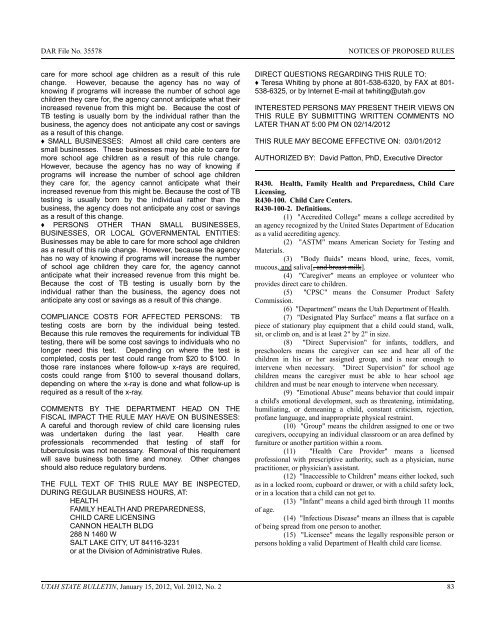
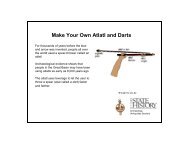
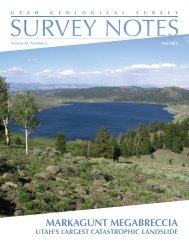
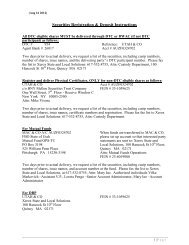
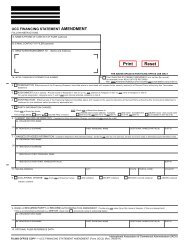
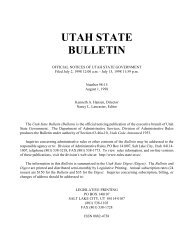
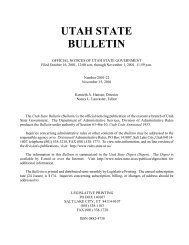

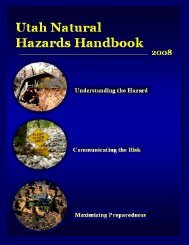
![Lynx avoidance [PDF] - Wisconsin Department of Natural Resources](https://img.yumpu.com/41279089/1/159x260/lynx-avoidance-pdf-wisconsin-department-of-natural-resources.jpg?quality=85)
